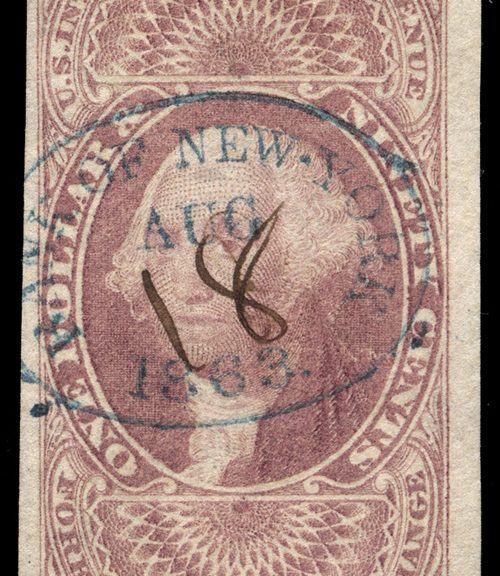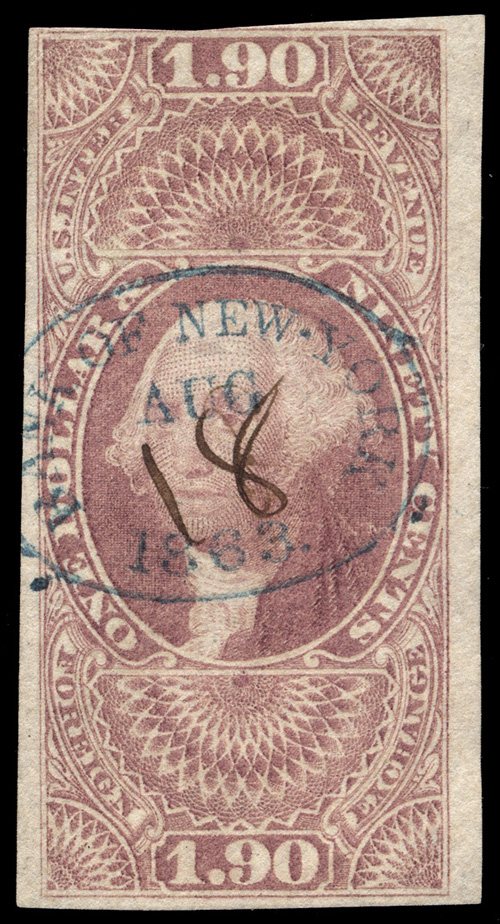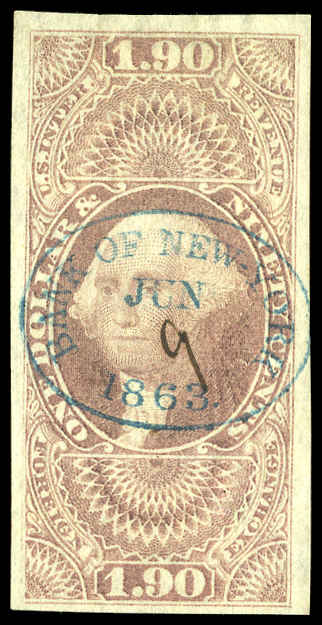
Finally harpooned one of my white whales!
When I first started collecting U.S. revenues about 15 years ago, I neglected to follow some sage advice from my coin collecting days: “Buy the keys first!”
What this means is that if you have the ability, buy the key dates or key pieces first… the rarest or highest catalog values FIRST. Most people, myself included, do the exact opposite, starting with the most common, cheapest, and/or easiest to find material.
It’s the exact WRONG way to go about building a collection that includes scarce items, in my opinion, if you want the best chance at actually completing it.
Why? When it comes to collectibles, common will always be common and cheap will always be cheap. It is almost universally the highest catalog value pieces and/or the most scarce pieces that tend to appreciate the fastest. Sometimes they appreciate enough that they become unobtainable.
I realize that not everyone can afford the same magnitude of philatelic purchases, but if you can, and have the necessary expertise, get the higher value pieces in your collecting specialties, because if you wait too long, they might just slip out of grasp… or you may find yourself having to settle for a subpar example just to fill the spot.
U.S. revenues have seen ginormous increases in demand and catalog value in the last 15-20 years, to the point that some 1st issue keys have just soared into the stratosphere.
For example, it is highly unlikely that I will ever own an R17a, the 3-cent Playing Card imperforate. When I first started tracking revenue values, in the 1999 Scott it listed for $8,500… considerably more than I have ever paid for a stamp, but now 17 years later, it lists for a whopping $40,000. That’s just not in the realm of possibility. Some other examples:
- R51b – then $900. Now $5,000.
- R77a – then $3,000. Now $10,000.
- R84a – then $2,500. Now $10,000.
- R80a – then $3,750. Now $12,500.
This time around, the quarry in question was R80a, the $1.90 Foreign Exchange imperforate, now cataloging $12,500, making it the second-highest catalog value 1st issue revenue stamp. Completely sound examples currently go in the $7,000+ range. You can find examples in the $2,000-5,000 range, but usually with multiple faults and poor aesthetics. I’ve seen many examples I don’t believe are legit, even with certs. Margins too iffy, color the wrong shade, cancels all wrong for the early period, etc.
Given my collecting focus on handstamp cancels, I really wanted an example with a handstamp cancel. Finding a legit R80a with a handstamp cancel and decent aesthetics without breaking the bank is an almost impossible proposition… and I’ve been looking for a long time. I have passed on several opportunities in the $2,000-4,000 range simply because I didn’t like the stamps for the money. If I’m going to spend 4 figures on a stamp or document, I have to really like it. I’ve only hit the 4-figure mark a handful of times in 15 years, and only figures starting with the number 1…
Well, there was an example offered a few weeks back in a Kelleher auction that hit all the sweet spots for me: great margins, the correct color and impression for an R80a, nice handstamp cancel, and only minor faults that didn’t majorly affect appearance.
I decided to lay in the weeds and see if I could snag it, knowing it would be a long shot. I knew I would have to pay up, but was hoping bidding wouldn’t go crazy and it would stay in the realm of feasible.
Well, I had to bid a few times, but I ended up with the stamp at a price I can live with (the 18% buyer’s premium really makes you wince though). It’s the most expensive stamp I’ve ever purchased, but I’m definitely pleased to “fill the spot” with an example that has a handstamp cancel.
I realize that it can be iffy to buy an expensive imperf without a cert, and had I any doubts, I would have put it on extension. This one, however, gives me no warnings at all. The left and right margins are wide enough to preclude it being a trimmed perf (if you look at multiples of R80c, they are printed VERY close together). The color is right, the cancel date is good, the impression is right. I have only ever seen this particular handstamp cancel on other R80a, not R80c (I’m not saying it wasn’t used on R80c, just that I have only ever seen it on R80a). It all rings true.
It has two shallow thin spots less than 2mm in size and the top margin touches the design; those are the only faults. I’m quite pleased.
Here is an example from the Philatelic Foundation certficate archive with the same cancel. By way of comparison, this stamp sold for $9,200 in 2008.

